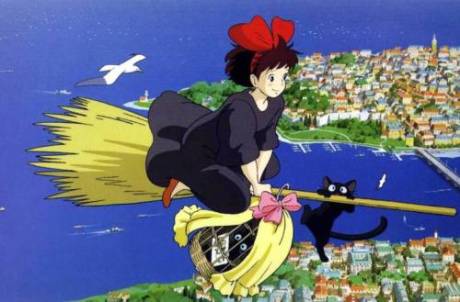
[…] Whilst a seemingly normal family film on its own merits, it is peculiar and unique viewed from the standpoint of 2018. It is specific to its production time of 1989, when anime (previously “Japanimation” in common parlance) began to find traction in mainstream consciousness in North America, with corporations like MGM and Fox producing English dubs. Kiki’s Delivery Service was the first Studio Ghibli film distributed by Walt Disney (in 1997), and looking at the source material, style, and content, it isn’t difficult to discern why. A thematically faithful, but loose on plot details, adaptation of a children’s book written in 1985 depicting a classic “European” Witch girl replete with broomstick and black cat, Kiki’s Delivery Service is something of an international anime. Both the film and book are set in a fictional Northern European country and feature native European characters, but is written and animated in tune with Japanese sensibilities. It is this Japanese slant on “Europeanness” that makes the film an interesting watch for ethnocentrically-minded, racially-conscious whites. […]
Again, this is a family film, but when us whites look at ourselves, we can tend towards the tragic-romantic or the tragi-comic, self-depreciation, gallows humor, the sardonic and ridiculous. In Kiki’s world (and anime at large), this element is almost entirely absent or manifested by otherworldly apparitions (for an extreme example, A Letter to Momo shows comedic demons who play the goof to an ordinary girl). It seems the Japanese are uncomfortable making dark jokes about themselves, even when looking through a European-tinted lens. It is this reverence for the ordinary which both beautifies Japanese society through well-regulated lifestyles and social harmony, and yet makes anime often incredibly tacky in its excessive seriousness and melodrama. Thankfully, extreme over-reaction has been toned down to suit the subject, and Kiki’s story centers on introverted self-realization over social capability. […]
[Read the rest of Buttercup Dew’s review at Counter-Currents.]

I haven’t yet listened to it, but like the narrator’s style.
https://mjolnirmagazine.blogspot.com/2018/06/mjolnir-at-movies-episode-vi-stanley.html
I’ll give it a listen.
I preferred Tyler, frankly.
Here’s an inspiring speaker for you. The “Make America White Again!” poster guy.
https://therightstuff.biz/2018/06/10/rebel-yell-20180604-318-rick-tyler-nationalist-solutions-conference/
A cat-loving, bohemian Japanese artist famous for the unique pallor of his nudes, turned Imperial Japanse war-artist.
https://www.theguardian.com/artanddesign/2018/apr/15/japanese-artist-leonard-foujita-more-feted-than-picasso-paris-1920s-exhibition
Dude, never go full Asian-Aryanist Bowlcut.
Spencer has already blazed a trail in the coiffeur stakes. This, if nothing else, will be his legacy.
Have you seen his recently minted mustache, though? Who is he LARPing as? Ned Flanders?
No, I had-diddly-aden’t. But it’s not too bad, actually. Thank God it wasn’t an Errol Flynn or Clark Gable try-on.